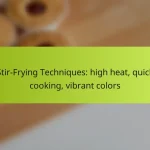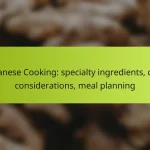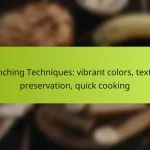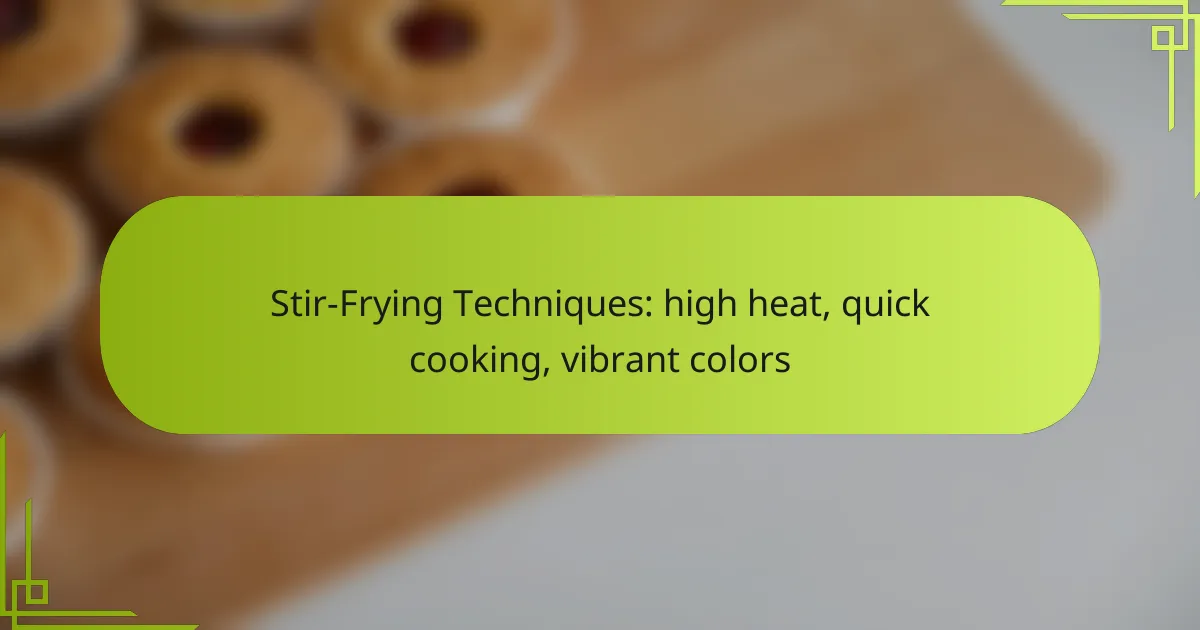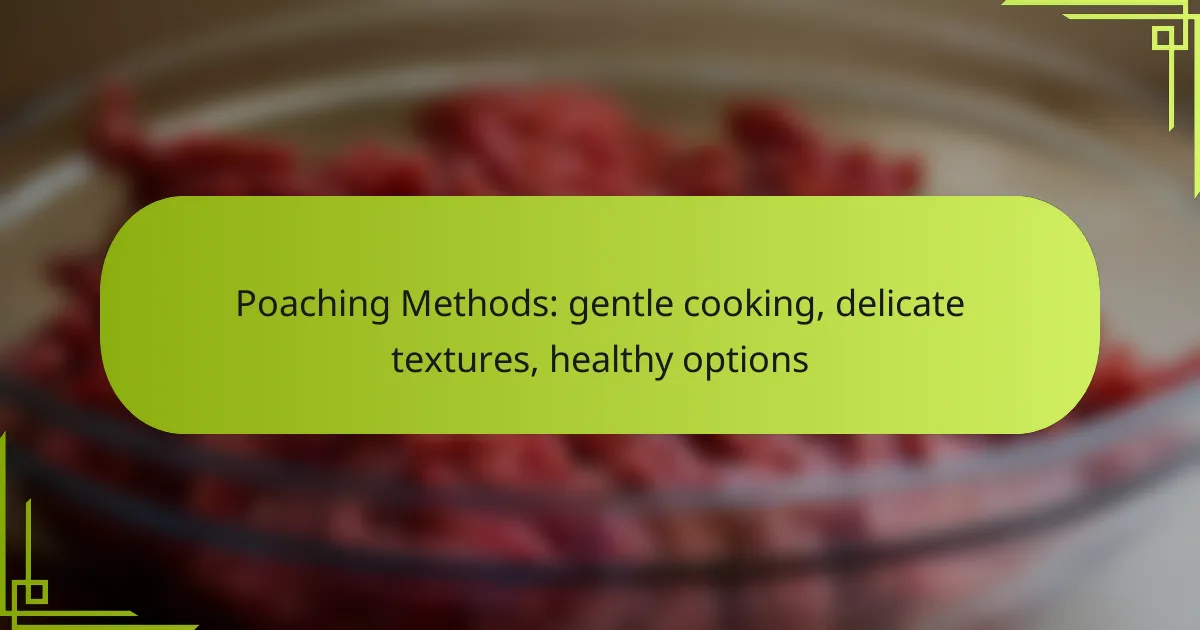Sautéing is a versatile cooking technique that emphasizes high heat and quick preparation, making it perfect for busy kitchens. By rapidly cooking ingredients, this method allows for rich flavor infusion while maintaining the nutritional integrity of your meals. With a focus on healthy options and smart ingredient choices, sautéing can transform simple dishes into flavorful and balanced culinary creations.

What are the best sautéing techniques for quick cooking?
The best sautéing techniques for quick cooking focus on high heat, efficient ingredient preparation, and smart use of tools. These methods help to infuse flavor while minimizing cooking time, making them ideal for busy kitchens.
High-heat cooking
High-heat cooking is essential for sautéing as it allows food to cook quickly while developing a rich flavor. Use temperatures around 400°F to 450°F (200°C to 230°C) to achieve a nice sear on proteins and vegetables. This technique helps to lock in moisture and enhances the overall taste.
Be cautious not to overcrowd the pan, as this can lower the temperature and lead to steaming instead of sautéing. Cook in batches if necessary to maintain the right heat level.
Using a non-stick skillet
A non-stick skillet is a practical choice for sautéing, as it requires less oil and makes for easier cleanup. These pans allow food to brown without sticking, which is crucial for achieving that desirable caramelization. Look for options that can withstand high temperatures for optimal results.
While non-stick pans are convenient, avoid using metal utensils that can scratch the surface. Instead, opt for silicone or wooden tools to preserve the coating.
Prepping ingredients in advance
Prepping ingredients in advance is key to quick sautéing. Chop vegetables and proteins into uniform sizes to ensure even cooking and reduce preparation time. Having everything ready to go allows you to focus on the cooking process without interruptions.
Consider using a mise en place approach, where all ingredients are measured and arranged before starting. This method streamlines the cooking process and enhances efficiency.
Utilizing a lid for steam
Using a lid while sautéing can help to speed up cooking by trapping steam and heat. This technique is particularly useful for thicker vegetables or proteins that require more time to cook through. Covering the pan for a short period can help soften ingredients without losing moisture.
However, be mindful not to cover the pan for too long, as this can lead to overcooking. Remove the lid periodically to check for doneness and to allow excess moisture to escape.
Batch cooking for efficiency
Batch cooking is an effective strategy for maximizing efficiency in sautéing. Prepare larger quantities of ingredients at once, then sauté them in portions as needed. This approach not only saves time but also allows for easy meal prep throughout the week.
Store cooked ingredients in airtight containers in the refrigerator for up to a few days. Reheat them quickly in the skillet for a fast meal option, ensuring you maintain the original flavors and textures.

How can sautéing enhance flavor infusion?
Sautéing enhances flavor infusion by quickly cooking ingredients at high heat, allowing their natural flavors to meld and intensify. This technique promotes the release of essential oils and compounds, creating a rich base for dishes.
Using aromatics like garlic and onions
Aromatics such as garlic and onions are fundamental in sautéing, as they provide a strong flavor foundation. Start by cooking diced onions until translucent, then add minced garlic for a fragrant boost. This combination can elevate the taste of almost any dish.
To maximize flavor, sauté these aromatics in a suitable oil, like olive or canola, over medium heat. Avoid burning them, as this can lead to bitterness.
Incorporating herbs and spices
Adding herbs and spices during the sautéing process can significantly enhance flavor. Fresh herbs like thyme, rosemary, or basil should be added towards the end of cooking to preserve their vibrant taste, while dried spices can be introduced earlier to allow their flavors to develop.
Consider using a mix of spices such as paprika, cumin, or chili powder to create depth. A pinch of salt can also help to bring out the flavors of the ingredients.
Deglazing with wine or broth
Deglazing is a technique that involves adding liquid, such as wine or broth, to the pan after sautéing to lift the flavorful bits stuck to the bottom. This process creates a rich sauce that enhances the overall dish.
When deglazing, choose a liquid that complements your ingredients. For instance, white wine pairs well with chicken or seafood, while vegetable broth is great for vegetarian dishes. Scrape the bottom of the pan to incorporate all the flavors.
Adding acid for brightness
Incorporating an acidic element, such as lemon juice or vinegar, can brighten the flavors of a sautéed dish. Acid helps to balance richness and enhances the overall taste profile.
Consider adding a splash of vinegar or a squeeze of lemon juice just before serving. This technique works well with sautéed vegetables, meats, and sauces, providing a refreshing contrast.
Layering flavors with timing
Timing is crucial when sautéing to ensure that flavors are layered effectively. Start with ingredients that take longer to cook, such as root vegetables, and gradually add quicker-cooking items like leafy greens.
For optimal results, consider the cooking times of each ingredient and adjust accordingly. This method allows each component to contribute its unique flavor without becoming overcooked or losing texture.

What are healthy sautéing options for meals?
Healthy sautéing options focus on using nutritious ingredients and cooking methods that enhance flavor without adding excessive calories or unhealthy fats. By selecting the right oils, proteins, and vegetables, you can create balanced meals that are both delicious and good for you.
Using olive oil or avocado oil
Olive oil and avocado oil are excellent choices for sautéing due to their high smoke points and healthy fat content. Both oils contain monounsaturated fats, which can support heart health and provide essential nutrients. Aim to use about one to two tablespoons per meal to keep your dishes flavorful yet healthy.
Incorporating vegetables for nutrition
Adding a variety of vegetables to your sauté not only boosts nutritional value but also enhances flavor and texture. Aim for a colorful mix, such as bell peppers, spinach, and broccoli, which provide vitamins, minerals, and antioxidants. A good rule of thumb is to fill half your sauté pan with vegetables for a balanced meal.
Choosing lean proteins like chicken or fish
Opting for lean proteins such as chicken breast or fish can make your sauté healthier while still satisfying. These proteins are lower in saturated fat and calories compared to red meats. Consider using around 100 to 150 grams of protein per serving to maintain a balanced diet.
Controlling portion sizes
Portion control is crucial for maintaining a healthy diet while sautéing. Use measuring cups or a food scale to ensure you’re not exceeding recommended serving sizes. A practical approach is to aim for one serving of protein, two servings of vegetables, and a small amount of healthy fat per meal.
Using low-sodium seasonings
To keep your sauté flavorful without excess sodium, opt for low-sodium seasonings and herbs. Fresh herbs, spices, and citrus juices can enhance the taste of your dishes without the health risks associated with high sodium intake. Experiment with garlic, basil, or lemon zest to add depth to your meals.

What equipment is essential for sautéing?
Essential equipment for sautéing includes a good quality skillet, a spatula, and a sharp knife. These tools help achieve quick cooking, enhance flavor infusion, and support healthy meal preparation.
Choosing the right skillet
Selecting the right skillet is crucial for effective sautéing. A heavy-bottomed skillet, preferably made of stainless steel or cast iron, distributes heat evenly and prevents food from sticking. Non-stick options are also available but may not provide the same level of browning.
Consider the size of the skillet based on the quantity of food you plan to cook. A 10 to 12-inch skillet is generally suitable for most home cooking, allowing enough space for ingredients to move freely without overcrowding.
Using a spatula for flipping
A sturdy spatula is essential for flipping and stirring ingredients while sautéing. Silicone or wooden spatulas are ideal as they are gentle on non-stick surfaces and can withstand high temperatures. Avoid metal spatulas on non-stick pans to prevent scratching.
When flipping food, use a quick wrist motion to turn items without breaking them apart. This technique helps maintain the integrity of delicate ingredients like fish or vegetables.
Investing in a quality knife
A sharp, quality knife is vital for efficient food prep before sautéing. A chef’s knife is versatile and can handle various tasks, from chopping vegetables to slicing meats. A well-maintained knife improves safety and speed in the kitchen.
Regularly honing and sharpening your knife ensures it remains effective. Consider investing in a knife sharpener or professional sharpening service to keep your tools in top condition, enhancing your overall cooking experience.

What are common mistakes in sautéing?
Common mistakes in sautéing can lead to uneven cooking and loss of flavor. Key errors include overcrowding the pan, using insufficient heat, and neglecting to properly prepare ingredients.
Overcrowding the pan
Overcrowding the pan is a frequent mistake that can prevent proper sautéing. When too many ingredients are added at once, they release moisture, which steams rather than browns the food. This results in a soggy texture instead of the desired crispness.
To avoid overcrowding, aim to fill the pan no more than half full. For instance, if you’re cooking vegetables, work in batches if necessary. This ensures each piece has enough space to sear and develop flavor.
As a rule of thumb, consider using a larger pan or reducing the quantity of food per batch. This simple adjustment can significantly enhance the quality of your sautéed dishes.
